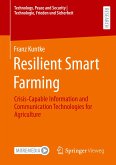Resilience Engineering Perspectives, Volume 2
Preparation and Restoration
Herausgeber: Hollnagel, Erik; Nemeth, Christopher P.
Resilience Engineering Perspectives, Volume 2
Preparation and Restoration
Herausgeber: Hollnagel, Erik; Nemeth, Christopher P.
- Broschiertes Buch
- Merkliste
- Auf die Merkliste
- Bewerten Bewerten
- Teilen
- Produkt teilen
- Produkterinnerung
- Produkterinnerung
Preparation and Restoration addresses issues such as the nature of resilience; the similarities and differences between resilience and traditional ideas of system performance; how systems cope with varying demands and sometimes succeed and sometimes fail; how an organization's ways of preparing before critical events can enable or impede restoration; the trade-offs that are needed for systems to operate and survive; instances of brittle or resilient systems; how work practices affect resilience; the relationship between resilience and safety; and what improves or erodes resilience.
Andere Kunden interessierten sich auch für
![Resilience Engineering Perspectives, Volume 2 Resilience Engineering Perspectives, Volume 2]() Resilience Engineering Perspectives, Volume 2168,99 €
Resilience Engineering Perspectives, Volume 2168,99 €![Risk Analysis and Management: Engineering Resilience Risk Analysis and Management: Engineering Resilience]() Ivo HäringRisk Analysis and Management: Engineering Resilience76,99 €
Ivo HäringRisk Analysis and Management: Engineering Resilience76,99 €![Advances in Automotive Production Technology - Towards Software-Defined Manufacturing and Resilient Supply Chains Advances in Automotive Production Technology - Towards Software-Defined Manufacturing and Resilient Supply Chains]() Advances in Automotive Production Technology - Towards Software-Defined Manufacturing and Resilient Supply Chains31,99 €
Advances in Automotive Production Technology - Towards Software-Defined Manufacturing and Resilient Supply Chains31,99 €![Advances in Automotive Production Technology - Towards Software-Defined Manufacturing and Resilient Supply Chains Advances in Automotive Production Technology - Towards Software-Defined Manufacturing and Resilient Supply Chains]() Advances in Automotive Production Technology - Towards Software-Defined Manufacturing and Resilient Supply Chains38,99 €
Advances in Automotive Production Technology - Towards Software-Defined Manufacturing and Resilient Supply Chains38,99 €![FOUNDATIONS OF RESILIENCE FOUNDATIONS OF RESILIENCE]() Josefa CastilloFOUNDATIONS OF RESILIENCE29,99 €
Josefa CastilloFOUNDATIONS OF RESILIENCE29,99 €![Building Resilience into Production: Contemporary Challenges for the Future Building Resilience into Production: Contemporary Challenges for the Future]() Building Resilience into Production: Contemporary Challenges for the Future151,99 €
Building Resilience into Production: Contemporary Challenges for the Future151,99 €![Resilient Smart Farming Resilient Smart Farming]() Franz KuntkeResilient Smart Farming83,99 €
Franz KuntkeResilient Smart Farming83,99 €-
-
-
Preparation and Restoration addresses issues such as the nature of resilience; the similarities and differences between resilience and traditional ideas of system performance; how systems cope with varying demands and sometimes succeed and sometimes fail; how an organization's ways of preparing before critical events can enable or impede restoration; the trade-offs that are needed for systems to operate and survive; instances of brittle or resilient systems; how work practices affect resilience; the relationship between resilience and safety; and what improves or erodes resilience.
Produktdetails
- Produktdetails
- Verlag: CRC Press
- Seitenzahl: 312
- Erscheinungstermin: 23. September 2019
- Englisch
- Abmessung: 234mm x 156mm x 17mm
- Gewicht: 477g
- ISBN-13: 9780367385408
- ISBN-10: 0367385406
- Artikelnr.: 57815044
- Herstellerkennzeichnung
- Libri GmbH
- Europaallee 1
- 36244 Bad Hersfeld
- gpsr@libri.de
- Verlag: CRC Press
- Seitenzahl: 312
- Erscheinungstermin: 23. September 2019
- Englisch
- Abmessung: 234mm x 156mm x 17mm
- Gewicht: 477g
- ISBN-13: 9780367385408
- ISBN-10: 0367385406
- Artikelnr.: 57815044
- Herstellerkennzeichnung
- Libri GmbH
- Europaallee 1
- 36244 Bad Hersfeld
- gpsr@libri.de
Dr Christopher P. Nemeth, Principal Scientist and Group Leader for Cognitive Systems Engineering, Klein Associates Division (KAD) of Applied Research Associates (ARA), USA, Professor Erik Hollnagel, Industrial Safety Chair at MINES ParisTech, France and Sidney Dekker is Professor and Director of the Key Centre for Ethics, Law, Justice and Governance at Griffith University in Brisbane, Australia. Previously Professor at Lund University, Sweden, and Director of the Leonardo Da Vinci Center for Complexity and Systems Thinking there, he gained his Ph.D. in Cognitive Systems Engineering from The Ohio State University, USA. He has worked in New Zealand, the Netherlands and England, been Senior Fellow at Nanyang Technological University in Singapore, Visiting Academic in the Department of Epidemiology and Preventive Medicine, Monash University in Melbourne, and Professor of Community Health Science at the Faculty of Medicine, University of Manitoba in Canada. Sidney is author of several best-selling books on system failure, human error, ethics and governance. He has been flying the Boeing 737NG part-time as airline pilot for the past few years. The OSU Foundation in the United States awards a yearly Sidney Dekker Critical Thinking Award.
Contents: The ability to adapt, Christopher P. Nemeth; Part I Policy and
Organization: The politics and policy challenges of disaster resilience,
Thomas A. Birkland and Sarah Waterman; Resilience capacity and strategic
agility: prerequisites for thriving in a dynamic environment, Cynthia
Lengnick-Hall and Tammy E. Beck. Part II Models and Measures: An initial
comparison of selected models of system resilience, David D. Woods, Jason
Schenk and Theodore T. Allen; Measuring resilience, John Wreathall. Part
III Elements and Traits: The 4 cornerstones of resilience engineering, Erik
Hollnagel; Ready for trouble: 2 faces of resilience, Ron Westrum; Layered
resilience, Philip J. Smith, Amy L. Spencer and Charles E. Billings. Part
IV Applications and Implications: Notes from underground: latent resiliency
in healthcare, Shawna J. Perry and Robert L. Wears; Cognitive underpinnings
of resilience: a case study of group decision in emergency response, David
Mendonça and Yao Hu; Restoration through preparation: is it possible?
Analysis of a low-probability/high-consequence event, Martin Nijhof and
Sidney Dekker; Understanding and contributing to resilient work systems,
Emilie M. Roth, Jordan Multer and Ronald Scott; The infusion device as a
source of healthcare resilience, Christopher P. Nemeth, Michael O'Connor
and Richard I. Cook; Bibliography; Index.
Organization: The politics and policy challenges of disaster resilience,
Thomas A. Birkland and Sarah Waterman; Resilience capacity and strategic
agility: prerequisites for thriving in a dynamic environment, Cynthia
Lengnick-Hall and Tammy E. Beck. Part II Models and Measures: An initial
comparison of selected models of system resilience, David D. Woods, Jason
Schenk and Theodore T. Allen; Measuring resilience, John Wreathall. Part
III Elements and Traits: The 4 cornerstones of resilience engineering, Erik
Hollnagel; Ready for trouble: 2 faces of resilience, Ron Westrum; Layered
resilience, Philip J. Smith, Amy L. Spencer and Charles E. Billings. Part
IV Applications and Implications: Notes from underground: latent resiliency
in healthcare, Shawna J. Perry and Robert L. Wears; Cognitive underpinnings
of resilience: a case study of group decision in emergency response, David
Mendonça and Yao Hu; Restoration through preparation: is it possible?
Analysis of a low-probability/high-consequence event, Martin Nijhof and
Sidney Dekker; Understanding and contributing to resilient work systems,
Emilie M. Roth, Jordan Multer and Ronald Scott; The infusion device as a
source of healthcare resilience, Christopher P. Nemeth, Michael O'Connor
and Richard I. Cook; Bibliography; Index.
Contents: The ability to adapt, Christopher P. Nemeth; Part I Policy and
Organization: The politics and policy challenges of disaster resilience,
Thomas A. Birkland and Sarah Waterman; Resilience capacity and strategic
agility: prerequisites for thriving in a dynamic environment, Cynthia
Lengnick-Hall and Tammy E. Beck. Part II Models and Measures: An initial
comparison of selected models of system resilience, David D. Woods, Jason
Schenk and Theodore T. Allen; Measuring resilience, John Wreathall. Part
III Elements and Traits: The 4 cornerstones of resilience engineering, Erik
Hollnagel; Ready for trouble: 2 faces of resilience, Ron Westrum; Layered
resilience, Philip J. Smith, Amy L. Spencer and Charles E. Billings. Part
IV Applications and Implications: Notes from underground: latent resiliency
in healthcare, Shawna J. Perry and Robert L. Wears; Cognitive underpinnings
of resilience: a case study of group decision in emergency response, David
Mendonça and Yao Hu; Restoration through preparation: is it possible?
Analysis of a low-probability/high-consequence event, Martin Nijhof and
Sidney Dekker; Understanding and contributing to resilient work systems,
Emilie M. Roth, Jordan Multer and Ronald Scott; The infusion device as a
source of healthcare resilience, Christopher P. Nemeth, Michael O'Connor
and Richard I. Cook; Bibliography; Index.
Organization: The politics and policy challenges of disaster resilience,
Thomas A. Birkland and Sarah Waterman; Resilience capacity and strategic
agility: prerequisites for thriving in a dynamic environment, Cynthia
Lengnick-Hall and Tammy E. Beck. Part II Models and Measures: An initial
comparison of selected models of system resilience, David D. Woods, Jason
Schenk and Theodore T. Allen; Measuring resilience, John Wreathall. Part
III Elements and Traits: The 4 cornerstones of resilience engineering, Erik
Hollnagel; Ready for trouble: 2 faces of resilience, Ron Westrum; Layered
resilience, Philip J. Smith, Amy L. Spencer and Charles E. Billings. Part
IV Applications and Implications: Notes from underground: latent resiliency
in healthcare, Shawna J. Perry and Robert L. Wears; Cognitive underpinnings
of resilience: a case study of group decision in emergency response, David
Mendonça and Yao Hu; Restoration through preparation: is it possible?
Analysis of a low-probability/high-consequence event, Martin Nijhof and
Sidney Dekker; Understanding and contributing to resilient work systems,
Emilie M. Roth, Jordan Multer and Ronald Scott; The infusion device as a
source of healthcare resilience, Christopher P. Nemeth, Michael O'Connor
and Richard I. Cook; Bibliography; Index.









